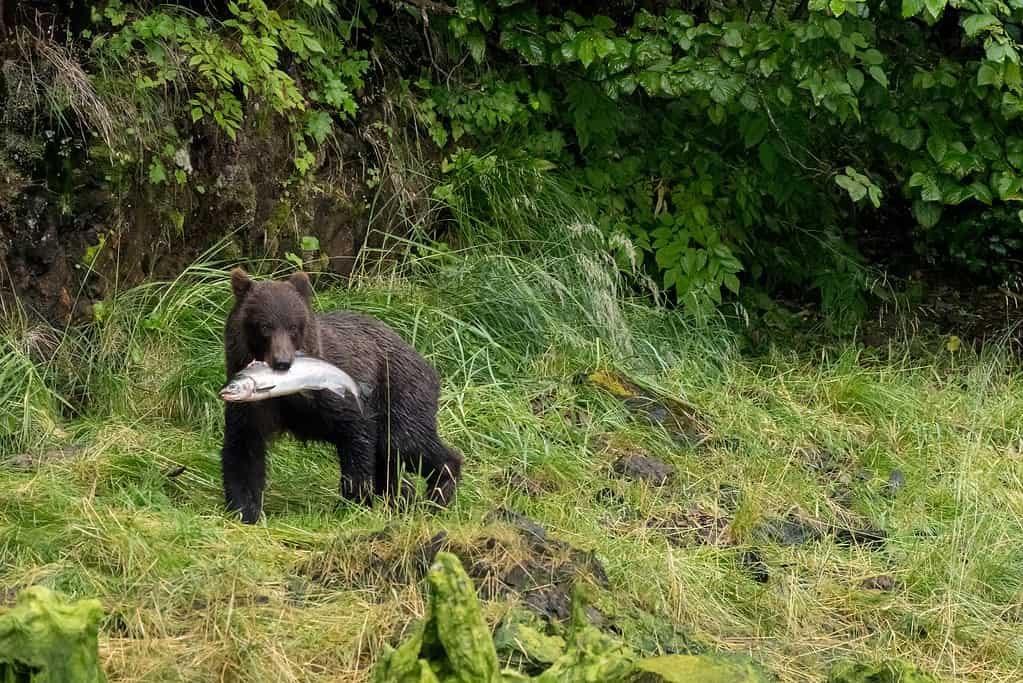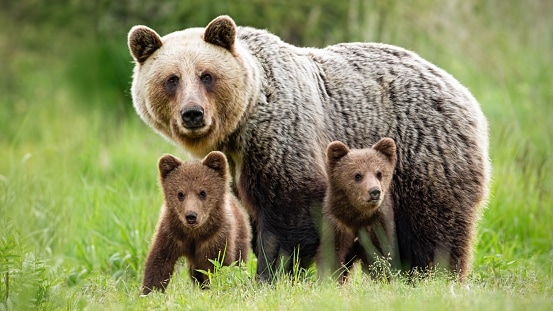Continue reading for our analysis...

You just can’t take your eyes off the kids for five minutes, can you?
Especially when you are near water! This mama bear has to leap into the rapids to help save her three cubs who have got into trouble. The strong current sweeps them over a small waterfall and it looks like they may get washed away!
Look down to see the full alarming clip which thankfully has a happy ending.
Why Do Bears Wade Into Water?

Bears can become experts at fishing!
©Birdiegal/Shutterstock.com
Both brown and black bears are omnivores. They can digest both plant and animal material. A large part of their diet is made up of vegetation however they also hunt animals to supplement their diet. Many bears like fish! They learn how to wade into the river and catch fish such as salmon as they are making their way upstream.
The waterfalls and rapids that are featured in this clip are an ideal location for a spot of fishing! The salmon hurl themselves out of the water as they are heading upstream and can be snatched by a hungry bear. Some bears become experts at fishing and perhaps this mama bear is trying to pass on her skills to her cubs.
However, the cubs are smaller and therefore in greater danger of getting swept away.
Can Bears Actually Swim?

Coastal Brown (Grizzly) bear (Ursus arctos horribilis) carrying a salmon in Southeastern Alaska, USA.
©Kirk Hewlett/ via Getty Images
Most bears can swim but some species are better at it than others. For example, polar bears are excellent swimmers. They can reach speeds of six miles an hour and spend quite a lot of time in the water traveling between ice floes.
Both brown bears and grizzly bears are able to swim but it is not something that they do very often. If they have to go into the water to get from one place to another, they are willing to do so but they get out of the water as soon as they can. Also, we know that grizzly bears do not tend to go into the water until they have reached a mature weight.
When black bears and brown bears swim, they use a ‘doggy paddle’ type of stroke. They float with their head above the water – helped by their high body fat content and oily coat. To propel themselves forward, they paddle mainly with their front limbs and don’t use their rear limbs much at all!
Is it Normal for Mother Bears to Put Their Cubs’ Safety First?

Protective female bears have learned that raising their cubs near humans provides greater safety.
©JMrocek/iStock via Getty Images
Mother bears have been observed displaying an astonishing degree of selflessness and protective tendencies when caring for their cubs. It’s no wonder that humans have adopted the phrase “mama bear” to describe their own protective feelings toward their children. The video shows that the mother bear not only rescues her cubs from the rapidly flowing water – but also remains calm as she assesses which cub needs help the most and proceeds to help one cub at a time. For a mother of three – this takes a lot of focus!
The greatest danger to cubs during their first year is not, however, falling into a rapidly flowing stream – it is the threat of being killed by adult male bears. Researchers in Norway have observed a new strategy adopted by female bears in that area that has increased their cubs’ chance of surviving their first precarious year of life. The bears are raising their young cubs close to the enemy of the male bear – humans.
While it is normal for female bears to move away from male territory after giving birth – female bears seem to have calculated that humans tend to hunt males while sparing a mother and her cubs. Researchers found that female bears that implemented this strategy and raised their cubs close to humans – but not too close – were much more successful raising their offspring to the age of independence – 1.5 – 2.5 years depending on the species. Perhaps that is why there are so many YouTube videos of mother bears and cubs enjoying swimming pools and hot tubs in people’s yards!
Thank you for reading! Have some feedback for us? Contact the AZ Animals editorial team.







